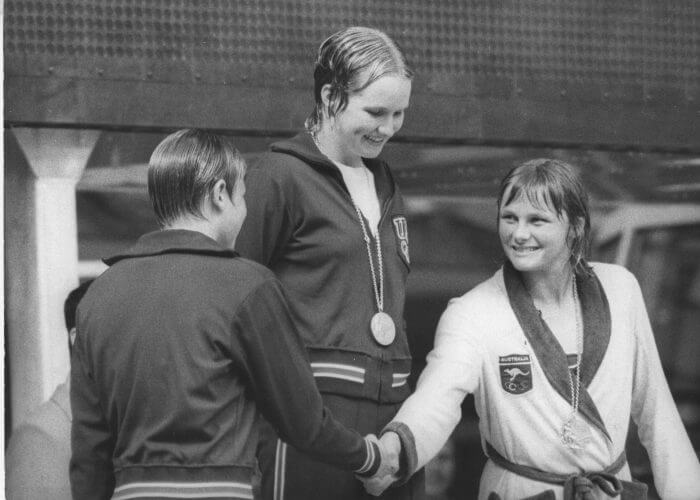From Past to Present: The Evolution and History Of Olympic Swimming

By Kaylie Williams, Swimming World College Intern.
Swimming continues to be a cornerstone event of the Olympic Games. But have you ever stopped to think about how the sport has evolved to the cutting-edge competition we witness today? Who was the first nation to introduce competitive swimming? Who held the first Olympic Games? How did Olympic swimming evolve to its current state? Keep reading to find out!
Early Origins

Photo Courtesy: Flickr
Swimming had its origins in Egypt as a leisure sport around 2500 BCE. According to britannica.com, archeological evidence has shown that ancient Greeks and Romans later used the practice to train soldiers for war to eventually become “part of elementary education for males.” They are also believed to have built the first swimming pools, distinctly different from their baths.
Evidence of a few races taking place in Japan around the 1st Century, BCE has also been uncovered. Not surprisingly, ancient Pacific Island natives are believed to have taught their children how to swim around the same time or even before they learned how to walk.
From Leisure to Competition

Photo Courtesy: Michael Gross/International Swimming Hall of Fame
Although swimming’s origins were rooted in leisure, the sport quickly evolved into a competition even before the first Olympic Games in 1896. In 1837, the first swimming organization was created in London and became known as England’s National Swimming Society. The name would later be changed to the Swimming Association of Great Britain in 1874.
During the 19th century, Australia—hungry for competition—began to hold regular championship races. In 1846, Australia held the first swimming championships. This was the first chance for different national teams to compete against each other and would dictate the future of competitive swimming. In the following years, various nations would host their own championship meets; the United States got their chance in 1877.
The First Olympic Games

Photo Courtesy: Shane Gould and Shirley Babashoff/International Swimming Hall of Fame
The first modern Olympic Games were held in Athens in 1896. According to the olympicchannel.com, swimming is “one of only four disciplines to have been retained, appearing in every summer Olympics since [the first Olympic Games] – the others being athletics, artistic gymnastics and fencing.” The first Olympics introduced some strange races into the lineup, as it was purely an experimental event to begin with. For example, the 100m free for sailors was strictly for members of the Greek Navy, and all of the races were held in open water.
Until 1912, only male swimmers were allowed to compete in the Olympics. It was not until the Stockholm Olympics that women were able to compete, and even when they were finally allowed in the water, they were only given two events in which to compete—the 100 free and 400 free relay.
Post World War Ⅱ to Modern Day

Photo Courtesy: John Naber/ International Swimming Hall of Fame
The era following World War Ⅱ was a bustling time for innovation and production. All of the economic growth from the war brought great technological advancement to the United States, which translated to the swimming world in the form of lane lines and indoor competition pools. Advanced training techniques and facilities such as hydrodynamic swimsuits and better drainage systems in the pools allowed athletes to swim much faster than those of the past. By 1924, marked lanes and guidelines for pool depths leveled the playing field and allowed for a more fair competition.
The 1950s and 1960s were full of advancement within the swimming world as new strokes and events made their debut over the following years. The butterfly stroke was first raced in 1956 at the Melbourne Olympics, and in 1968, the number of events jumped from eight to 14 for women and 10 to 15 for men.
The 1970s and 1980s saw the rise of superhuman swimmers such as Mark Spitz, Matt Biondi, Michael Gross and Kristen Otto. Their achievements are remembered and honored as they serve to motivate the top athletes of today, such as Katie Ledecky and, of course, Michael Phelps. Phelps is currently the most decorated Olympic athlete of all time, collecting a healthy 28 medals and is known for breaking Spitz’s record of seven consecutive first place finishes at one Olympic Game. Ledecky is well on her way to becoming one of the most decorated female swimmers in Olympic history with five Olympic gold medals, 14 world championship gold medals and six world records under her belt.
Swimming has come a long way since its early beginnings. Our present and future successes in competition can only be attributed to the struggles of past athletes. The rough years of early competition spurred innovation and advancement of training techniques and facilities that allow us to compete at the level we do today. For that, we should be grateful and work to appreciate and remember the proud history of swimming.
– All commentaries are the opinion of the author and do not necessarily reflect the views of Swimming World Magazine nor its staff.




going to Ballarat grammar located in Australia Victoria Ballarat and I’m giving away 1 million dollars
urgh can you shur up ?